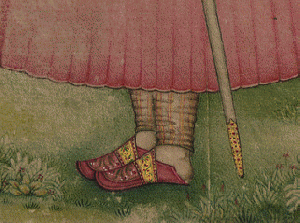| Back OpEd News | |||||||
|
Original Content at https://www.opednews.com/articles/The-Salt-Range-The-Past-G-by-Muhammad-Irfan-Authority_Glory-150902-623.html (Note: You can view every article as one long page if you sign up as an Advocate Member, or higher). |
|||||||
September 2, 2015
The Salt Range: The Past Glory (Part 2)
By Muhammad Irfan
This is the second part of the article, which covers the regal authority from the Mughal Era to the present scenario.
::::::::

Album of Persian and Indian calligraphy and paintings, A Mughal nobleman (detail of shoes).
(Image by Walters Art Museum Illuminated Manuscripts) Details DMCA
The Mughals Era
The Mughals, the descendents of Timor, succeeded in occupying the subcontinent with the help of the Janjua aristocracy of the Salt Range area. That is why these aristocrats enjoyed the privileged status in the empire. Nonetheless, they lost the favor in the house of Mughals during Hamayon Era in which the Janjuas sided with Suris who were ambitious to expel Hamayon and capture the throne. On the other hand, the Ghakhars of the area were the allies of the king Hamayon. This was the reason behind why Sher Shah Suri was bound to build the largest military fort in the subcontinent at Rohtas.
This was in fact aimed at subduing the turbulent Ghakhars and making them submissive. However, the Ghakhars were granted the entire Pothohar Region as vassal state by Hamayon on his successful return from Persia for retaking the Raj in the subcontinent. This was actually the recognition of Ghakhars loyalty and valor as well. Janjuas entered again in the royal house of the king in the Akber's era. Malik Dervesh Khan Janjua rose as the most prominent general of Akber's army. With regard to this close relation, Dervesh Khan changed the name of his famous fort Girjakh as Jalal Pur on Akber's name when the emperor visited this area. The Rohatas Fort has been the center of authority during the Mughal era.
The Sikh Era
Sikh perceived the Ghakhar as a threat to their rule. Later on, they in a tricky way succeeded in subduing the Ghakhar's resistance. During this struggle, Ranjeet Singh established his capital in Rohtas Fort for six months. After he ensured that the resistance had died down, he shifted the capital to Lahore. Similarly, in an 1848 battle of Challian Wala, the Janjuas of Chakri and Dara Pur supported the British against the Sikhs.
The British defeated the Sikh and snatched the area from them. During the British era, the Salt Range became again very important. The people of this soil were immensely recruited. It served as the breeding nursery for British armed forces. Raja Habib Ullah Khan of Dara Pur was the first in the subcontinent to get the British royal commission. In this span, the Jhelum cantonment was the first military garrison the British built in 1849 in the western part of subcontinent.
Pakistan (1947-present)
When Pakistan came into being in 1947, the area played again its robust role in providing the blood to the armed forces for the national security. At this time, three major generals out of four in Pakistan army were from the said area. The area still is on a high rank in providing soldiers.
This history of the past ends on the lesson that every stalwart will meet death and every bastion will cease to exist. The sole and eternal authority is Al-Mighty.
Authors Website: https://vision-313.blogspot.com
Authors Bio:
Muhammad Irfan has authored many books. He is an internationally recognized scholar. He has presented his papers in national and international conferences. He is also a freelance journalist and contributes to both national and international print media. Currently, he runs two blogs.